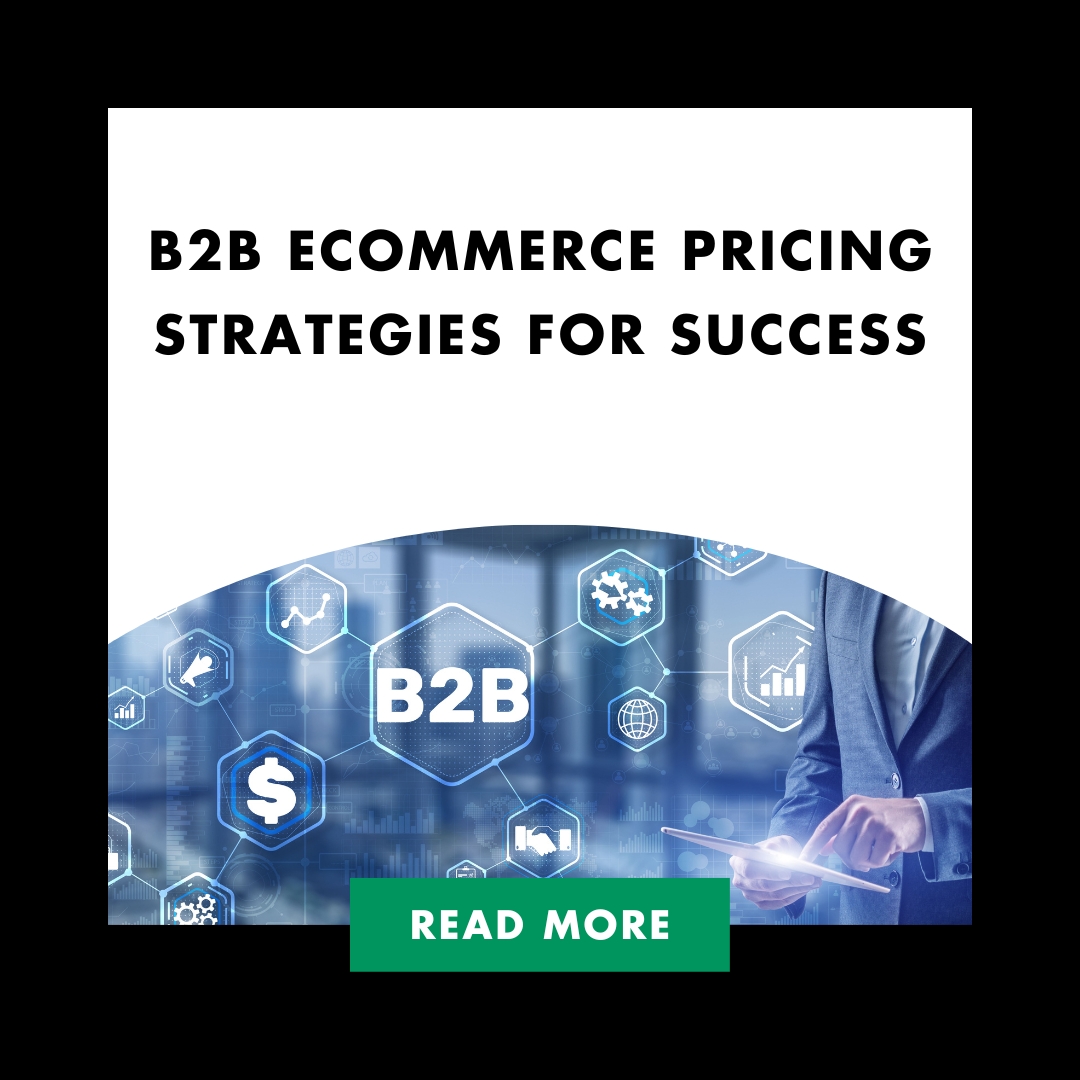B2B eCommerce Pricing Strategies for Success
Developing effective B2B eCommerce pricing strategies is crucial for businesses looking to thrive in today’s competitive market. A successful pricing plan can not only amplify sales but also enhance brand recognition and customer loyalty. This guide will provide an in-depth look into the intricacies of B2B eCommerce pricing, from penetration strategies to segmentation techniques and various models.
We will explore penetration pricing strategy and its potential pitfalls, as well as discuss the importance of segmenting customers based on their distinct needs using price segmentation techniques. Furthermore, you’ll learn about different B2B eCommerce pricing strategies such as free plus shipping model, bundle and dynamic pricing strategies, customer-specific and predatory pricing techniques.
In addition to these tactics, we will examine value-based vs cost-based methods and how they can be balanced depending on product lifecycle stages. The creation of distinct customer segments is another key aspect that we will cover along with aligning company operations with segment demands.
Lastly, transparency in B2B eCommerce pricing plays a vital role in building trust among customers; therefore, our guide includes tips on planning strategic discount campaigns while maintaining transparency. We’ll also demonstrate how leveraging data can help optimize your B2B eCommerce pricing strategies by analyzing market trends and consumer behavior patterns.
Table of Contents
Penetration Pricing Strategy
Looking to increase sales and average order value? Consider the penetration pricing strategy. By providing goods at a reduced cost, companies can draw in more customers and sell more items without incurring additional costs. But beware of common mistakes that can hinder long-term growth.
Researching Wholesale Prices in the Target Market
- Analyze competitor offerings to determine industry benchmarks for product pricing.
- Gather data from suppliers or trade associations to gain insights into typical cost structures.
- Evaluate customer demand patterns and price sensitivity when setting your initial rates.
Avoiding Pitfalls of Penetration Pricing
- Maintain profitability: Ensure your discounted prices still cover production costs and contribute towards desired profit margins.
- Avoid price wars: Monitor competitors’ reactions closely, but refrain from engaging in a race-to-the-bottom scenario with aggressive discounting tactics.
Remember, a consistent pricing strategy is key to building brand reputation and customer loyalty. Consider alternative pricing strategies, such as value-based, competition-based, or customer-specific pricing, to identify the optimal approach for your ecommerce business and target audience.
Value-Based and Cost-Based Pricing Methods
When it comes to B2B eCommerce, pricing strategies can make or break your business. The pricing approach selected is dependent on various elements, including market trends, consumer demand and competitively-based prices. Two pricing strategies commonly employed are value-based and cost-oriented.
Value-Based Pricing
Value-based pricing is a customer-centric approach that focuses on meeting customers’ expectations by setting the highest possible price without alienating potential clients. This strategy is particularly effective for established products with a strong brand reputation. To implement value-based pricing, analyze your target market’s perception of your product’s worth and set prices accordingly to maximize profits while maintaining customer satisfaction.
Cost-Based Pricing
Cost-based pricing, such as cost-plus pricing, can be useful when releasing new products with limited market data available. To utilize cost-based methods, determine the total cost of production and add a desired profit margin to establish a consistent pricing strategy across all distribution channels.
Segmenting customers and offering personalized pricing can also be effective in increasing profits. For example, customer-specific pricing or personalized pricing can be used to target different customer segments with different price points. Bundle pricing or bundled pricing can also be used to offer discounts to customers who purchase multiple products.
Staying consistent in your pricing approach is essential to promote brand recognition and drive sales growth over time. Customers perceive companies that have a consistent pricing strategy as reliable and trustworthy.
Overall, choosing the right pricing strategy depends on your target market, product, and desired profit. By understanding your potential customers and segmenting them accordingly, you can drive sales and increase profits for your eCommerce business.
Pricing Segmentation Techniques
For B2B eCommerce, pricing segmentation is crucial to cater to the diverse needs of your target audience. By identifying distinct customer segments and tailoring price points for each, you can create a personalized shopping experience that encourages repeat business.
Identifying Customer Segments
- Market Data Analysis: Analyze market data to determine unique characteristics of different buyer groups, such as industry sector, company size, or purchasing behavior.
- Customer Persona: Create customer personas to understand the needs and preferences of your target audience.
Tailoring Price Points
- Value-Based Pricing: Offer value-based pricing for customers who prioritize quality over cost savings.
- Competitive Pricing: Implement competition-based pricing to stay competitive in the market.
- Dynamic Pricing: Use dynamic pricing to adjust prices based on market conditions and customer demand.
- Bundled Pricing: Offer bundled pricing to increase sales and drive customer loyalty.
By incorporating these pricing strategies, you can boost brand awareness, increase profits, and enhance overall customer satisfaction. Remember, a consistent pricing strategy depends on segmenting customers and adjusting prices based on their needs and preferences.
Transparency in Product Prices
Don’t hide your product prices from potential customers. Being transparent builds trust and helps establish a healthy relationship between you and your buyers. Always be upfront about your pricing strategy, and if you need to offer discounts, make sure you communicate the original value before the reduction takes effect.
The Importance of Transparent Communication with Customers
Being open and honest about your pricing information helps build customer loyalty and encourages repeat business. It also prevents misunderstandings that can lead to dissatisfaction or lost sales. Transparency is key to maintaining a consistent pricing strategy and keeping your customers happy.
Planning Strategic Discount Campaigns
Offer discounts strategically by analyzing market conditions, competitor offerings, and customer demand patterns. This approach ensures you can provide value without compromising on profitability or brand reputation. By segmenting customers and understanding their needs, you can create personalized pricing strategies that drive sales and increase profits.
- Dynamic Pricing: Use dynamic pricing to adjust your prices based on market conditions, customer demand, and other factors. This approach allows you to stay competitive and maximize profits.
- Bundled Pricing: Bundle your products together to create value for your customers and increase your average order value. This approach is especially effective for ecommerce businesses.
- Freemium Pricing: Offer a free version of your product to attract potential customers and upsell them to a paid version with more features.
Remember, your pricing strategy depends on your target market, customer persona, and desired profit. By understanding your customers and their needs, you can create a consistent pricing strategy that boosts brand awareness and drives sales.
Product-Level Customization and Bundling Techniques
Customizing prices at the product level has been shown to increase profits by over 20%. Bundling primary purchases with supplementary supplies is another way businesses can boost revenues while catering more closely towards individual client requirements and expectations.
Product-Level Customization
Implementing product-level customization techniques allows eCommerce businesses to better target specific customer segments and increase sales. By offering personalized pricing, businesses can provide a more tailored experience that meets each buyer’s unique needs. This approach has been proven to boost brand awareness and increase profits.
Bundling for Increased Average Order Value
Offering bundle deals that combine complementary products in a single package provides added value to customers and encourages them to spend more on their purchase. This strategy helps drive up overall revenue while enhancing customer satisfaction. By segmenting customers and understanding their demand, businesses can create bundled pricing that appeals to potential customers and increases conversion rates.
Product-level customization and bundling techniques are consistent pricing strategies that can help businesses stand out in a competitive pricing landscape. By understanding market conditions and customer segments, businesses can price products differently and drive sales while achieving their desired profit.
Product-Level Customization and Bundling Techniques
Customizing prices at the product level has been shown to increase profits by over 20%. Bundling primary purchases with supplementary supplies is another way businesses can boost revenues while catering more closely towards individual client requirements and expectations.
Product-Level Customization
Implementing product-level customization techniques allows eCommerce businesses to better target specific customer segments and increase sales. By offering personalized pricing, businesses can provide a more tailored experience that meets each buyer’s unique needs. This approach has been proven to boost brand awareness and increase profits.
Bundling for Increased Average Order Value
Offering bundle deals that combine complementary products in a single package provides added value to customers and encourages them to spend more on their purchase. This strategy helps drive up overall revenue while enhancing customer satisfaction. By segmenting customers and understanding their demand, businesses can create bundled pricing that appeals to potential customers and increases conversion rates.
Product-level customization and bundling techniques are consistent pricing strategies that can help businesses stand out in a competitive pricing landscape. By understanding market conditions and customer segments, businesses can price products differently and drive sales while achieving their desired profit.
Bulk Discounts and Dynamic Pricing Approaches
Offering bulk discounts is a great way to encourage larger orders from potential customers. It’s important to research your competitors’ pricing strategies and analyze market conditions to determine the optimal discount levels for your industry. This ensures maximum profitability without sacrificing quality service delivery standards.
Determining Optimal Bulk Discount Levels
- Research Competitors: Analyze your competitors’ pricing strategies to determine the best discount levels for your products or services.
- Analyze Market Conditions: Keep an eye on market conditions to ensure your pricing strategy remains consistent and competitive.
Dynamic pricing is another approach that enables companies to adjust prices in real-time based on market demands. This method allows you to stay ahead of the curve by adapting to emerging trends and customer personas. Utilize data analysis tools like Google Analytics or Tableau for insights into customer demand patterns and preferences.
Adapting Dynamic Pricing Strategies
- Utilize Data Analysis Tools: Use tools like Google Analytics or Tableau to analyze customer demand patterns and preferences.
- Stay Ahead of the Curve: Adapt to emerging trends and customer personas to stay ahead of the competition.
By implementing bulk discounts and dynamic pricing strategies, you can increase sales, boost brand awareness, and increase profits. Remember to segment your customers and personalize your pricing approach to meet their needs and expectations. With the right pricing strategy, you can drive sales and achieve your desired profit margins.
FAQs in Relation to B2B Ecommerce Pricing Strategies
Penetration pricing, value-based and cost-based methods, customer segmentation techniques, bundle and dynamic pricing strategies are all effective ways to attract customers while maintaining profitability.
Creating a seamless online experience for business clients involves tailored product catalogs, personalized discounts, efficient order processing systems, and excellent customer support.
Companies determine their product’s price by adding a markup percentage to production costs such as materials expenses or labor charges involved during manufacturing processes.
B2B strategies focus on creating long-term relationships, offering bulk discounts, and tailoring pricing based on customer segments, while B2C tactics may include psychological pricing, freemium models, and promotional offers.
Conclusion
Want to succeed in B2B eCommerce? Understanding pricing strategies is key.
Penetration pricing and pricing segmentation can help create distinct customer segments, while free plus shipping and bundle strategies can optimize profitability.
Transparency in pricing and leveraging data analytics are also important factors to consider.
Check out Shopify for more information on B2B eCommerce pricing strategies.
Want to Talk Strategy?
Is this something you're looking to dive deeper into? Sign up for a free strategy session with our team!
Let's TalkSubscribe for New Content
Share on Social
New Posts to Check Out

Website Architecture for Beverage Brands: Hubs, Product Pages & Local SEO

Restructuring Your 2026 Staffing Site: Hubs, Clusters and Service Pages

AEO vs. SEO for THC Beverages: Winning Answers in AI & Organic


How to Choose a THC Beverage Marketing Agency for Fastest Growth

AEO vs. SEO for Staffing: How to Win Answers in AI Overviews and Chat

Why We Build Content Around Funnel Stages, Not Keywords

SEO in 2025: How Staffing Firms and B2B Marketers Can Win


